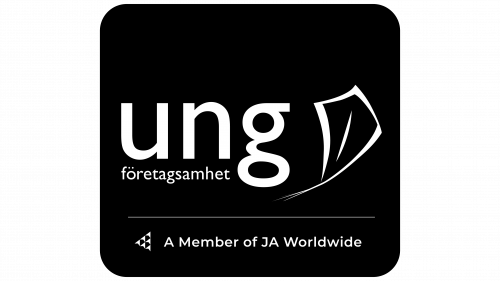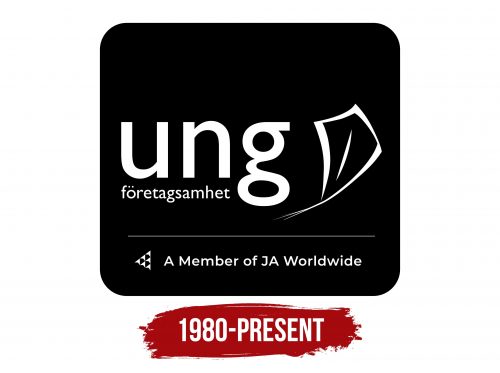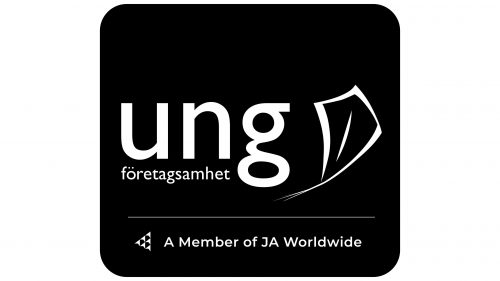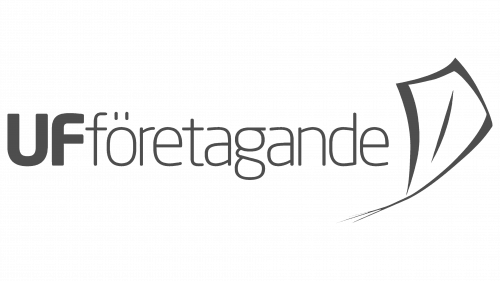The Ung företagsamhet logo is like a beam of light breaking through the darkness, showing the way to a happy future. The emblem features lightness and fine lines, emphasizing the youth of its participants.
Ung Företagsamhet: Brand overview
In 1980, Sweden saw the emergence of a unique educational initiative – Ung Företagsamhet (UF), which became the local branch of the global organization Junior Achievement. UF is focused on stimulating entrepreneurial skills among schoolchildren and students, pursuing non-commercial goals while maintaining political independence.
At the core of UF’s activities is the UF-företagande program, designed for high school students. This program offers young people the opportunity to create and manage their own mini-enterprises, teaching them important aspects of business and entrepreneurship. Additionally, UF develops educational materials for younger students, including courses like “Vårt samhälle” (Our Society), “Se möjligheterna” (See the Opportunities), and “Min framtid och ekonomi” (My Future and Economy), to inspire students to explore economic concepts from an early age.
Since its inception, over 560,000 students have participated in UF’s programs and launched their entrepreneurial projects. A study conducted by Karl Wennberg in 2011 demonstrated the significant benefits of participating in these programs: graduates of UF-företagare are more likely to become entrepreneurs, create successful companies, hire more employees, and achieve higher turnover than those who did not participate in UF programs. The work of the organization is coordinated through a national office and 24 regional associations, and a team of over 100 employees provides support to students and teachers. UF is supported by both government and private funds, allowing the organization to expand its influence and inspire new generations to embark on the entrepreneurial path.
Meaning and History
The movement in Sweden originated in 1980. It can be presumed that the organization’s symbol was designed around this time. The emblem’s design is linked to the signs of the global movement of which the organization is a part. The composition is built on the concepts of simplicity, lightness, and accessibility. It combines children’s attributes and dreams.
The movement’s emblem consists of a black square with rounded corners. The precisely defined boundaries of the symbol signify community and union, which can be joined based on age or beliefs.
The equal length of the sides embodies equality among participants. It highlights tolerance and democracy. All young people, regardless of background, can participate in the program. More than 560,000 youths from Sweden have completed training in Ung.
What is Ung företagsamhet?
A youth movement in Sweden. It focuses on teaching schoolchildren the basics of business and entrepreneurship. It covers elementary, middle, high school, and university students. The country has 24 branches with 100 employees. The organization helps schoolchildren start small businesses and realize their dreams.
The name, represented by three large white lowercase letters Ung and a smaller subscript företagsamhet, directly targets a young audience – with participants ranging from 5 to 25 years old.
An important symbol in the logo is a kite. The toy conveys the idea of flight, starting, and aspiring upwards. Young people are the country’s future. They are just beginning their journey. The organizers aim to inspire participants and provide them with knowledge for a successful start in life. The kite symbolizes the fulfillment of wishes, as students in the program can start businesses and gain practical skills.
Underneath the thin, straight line at the bottom of the composition is an indication that the movement is part of the global organization JA Worldwide – a youth community covering 15 million boys and girls. JA stands for Junior Achievement and has existed for over 100 years. The main goal and task of JA closely intertwine with Ung företagsamhet and represent building a bright future for subsequent generations.
In the lower-left corner is the Worldwide emblem. The symbol is a paper airplane composed of many of its smaller copies. This sign is linked to the concept of the Ung logo. It encompasses the theme of flight and moving forward. The interweaving of small figures emphasizes teamwork and mutual support.
Interestingly, the elements in the airplane are united in such a way that empty space remains between them, mirroring the shape of Ung’s kite.
1980 – today
Font and Colors
The logo’s color scheme uses the idea of contrast. It juxtaposes light and dark, youth and the older generation, ignorance, and knowledge. According to the movement’s concept, young people, represented by the light tone, receive important knowledge at meetings and subsequently should impact the more positive development of the country and its economy.
The font of the inscription is smooth and thin: Acherus Feral Semibold.







